Yamal Express
 Overview
Overview Photos
Photos
April 12, 2013
Today we are going to present you our next photo essay. This time we have visited the Yamal Peninsula. In the first part of the photo essay published today we'll tell you about the Obskaya – Bovanenkovo railway. The second part will be devoted to the Bovanenkovo field and will be published soon.
The Obskaya – Bovanenkovo railway is the most northern of the existing railways in the world and the only reliable overground service connecting the mainland with a rotational camp at Bovanenkovo – the largest gas field on the Yamal Peninsula.
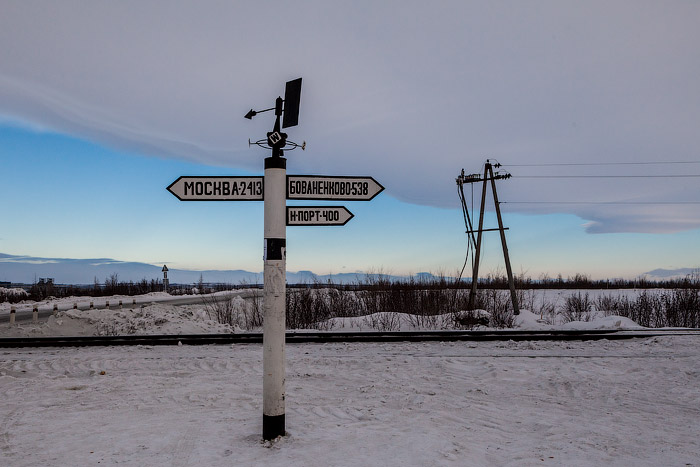
Trains heading for the Peninsula leave from the Obskaya 2 railway station. It is a short drive from the Labytnangi town, its name translated from Hanty means “seven larches”. It is from here where in December 1986 the Yamaltransstroi (construction and installation contractor) started building the railway track. The construction project was declared the Komsomol’s all-Union “shock work” project, brigades were sent to it along with construction trains from the Baikal-Amur Mainline.
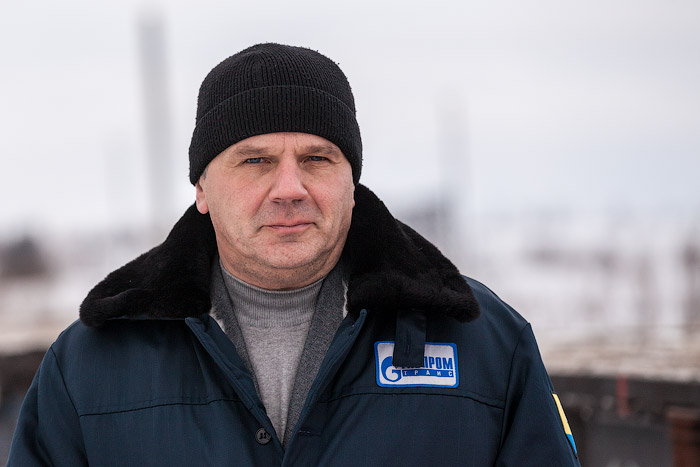
Viktor Kapustyuk, current station supervisor, arrived at the construction site together with the first group of Komsomol members. The North met him with a blizzard and a 53-degree cold. Viktor has never lived through lower temperatures since that time.
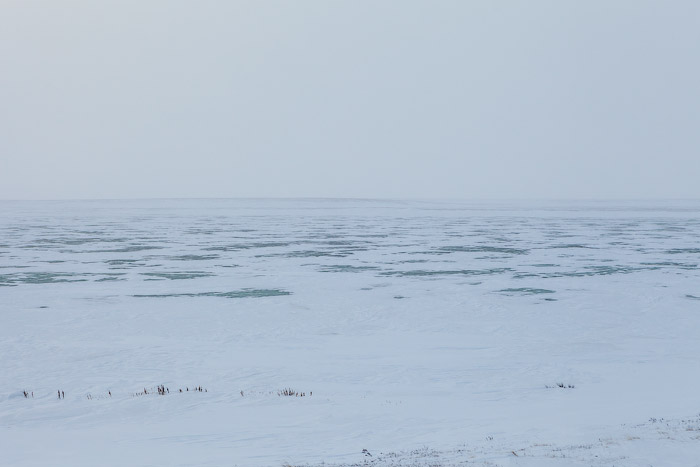
The land, he says, was so frozen that it took the workers two days to put the so-called ten-centimeter “golden spike” – a symbol of the beginning of the railway construction.

The weather did not favor the builders. In winter there were snowstorms and biting frosts, in summer – floods. But the construction process was never stopped. The railway construction was ceased in late 1980s. Until the end of “shock work” project financing, Komsomol builders had time to lay only half of the way – to the Khralov station.

After a while, some people left the Peninsula and others helped to keep the railway track in running order. Houses for the “shock workers” were built not far away from Labytnangi.

That way, the rotational camp turned into a microdistrict of a small town. Decades later, Gazprom decided to finish the construction started by the Soviet authorities. The Khralov station became the starting point. However, building on permafrost was not easy. Engineers had to develop a range of design solutions to reinforce the railway. Building on permafrost features a necessity to keep the whole structure fixed during the snowmelt season when the ground gets wet and softens.

The rail embankment is like a multi-layer cake. First, a two-meter layer of hard frozen soil and geofabric (a type of geotextile used in road and oil and gas pipelines construction) is laid on the frozen ground (construction in permafrost conditions is carried out only in winter). It keeps the soil temperature on the same level all year-round. Then it is covered with the polystyrene foam plate, filled with dry frozen and rocky soil and macadam, and, finally, rails are placed on this foundation.

The railway steadiness is also provided by heat stabilizers – temperature controllers. Two-meter pipes are filled with circulating freon being heated or cooled. Thus, the gas freezes the ground beneath the rails. Heat stabilizers are located near each of the manufactured structures, i.e. a bridge or a building. They provide steadiness of the permafrost layer.
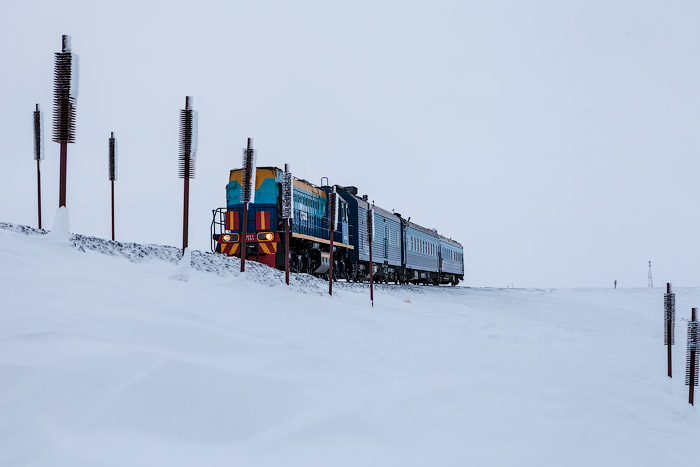
Engineers have also provided for a flood protection – more than three hundred pipes connecting the numerous rivers and lakes of Yamal are located under the railway. And over a hundred bridges were built along the entire route.

The Yamal residents believe that the bridge over the Shchuchya River is the most fascinating. It was built during the first stage of the railway construction, hundreds of kilometers away from the Obskaya 2 station. The Shchuchya River, of 30-meter depth in some places (because of the cleft), draws the line between wooded tundra and tundra.

The Yuribey River bridge is the longest bridge on the route. Its length comes to 3.9 kilometers and weight exceeding 3 thousand tons. The bridge is world’s unique in terms of construction procedure and operation – nobody could build a bridge of such a length in the permafrost surroundings beyond the Arctic Circle.

The Yuribey bridge is maintained by about two dozen workers. They live 2 kilometers away from the bridge and regularly check its supports and fasteners, monitor the embankment state and replace the failed rails under the surface-men supervision.
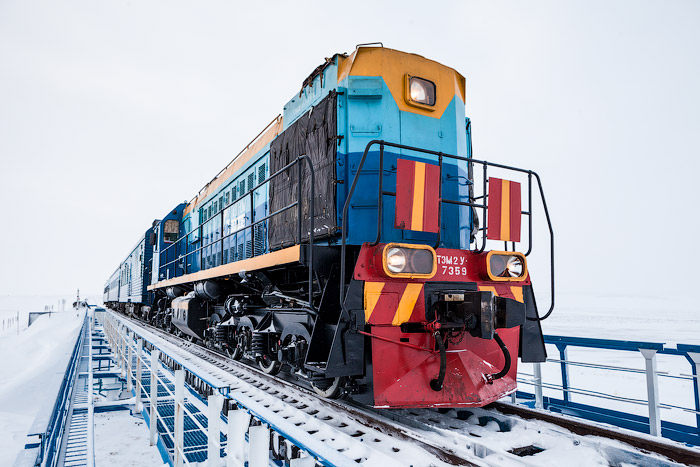
The Obskaya – Bovanenkovo railway stretches for 572 kilometers. It takes a day to get from the starting point to the final destination – the Karskaya station. The whole route features a lack of settlements, lamp posts and mobile coverage.
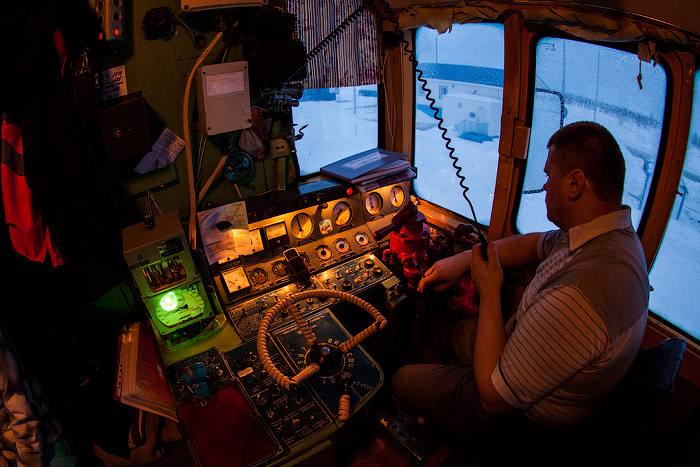
Sergey Pukhov, the train driver, shows the way of radio communication among the railroad men.
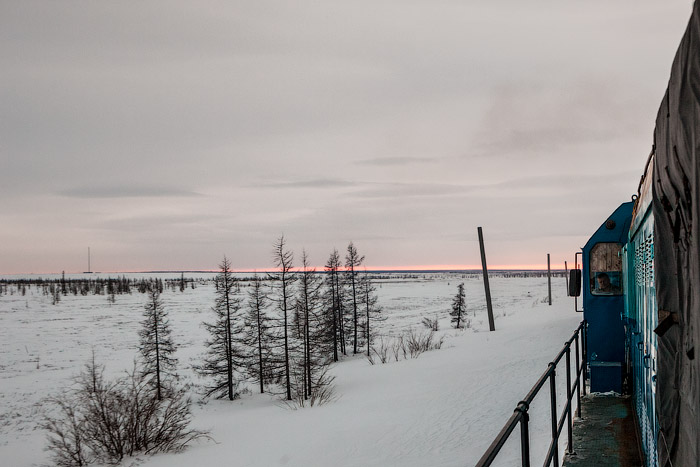
A clear day allows you to enjoy a view of the Ural Mountains and sparkling snow through the train window, watch wooded tundra turning into taiga and, if you are lucky, get a sight of plagues in the snowy wilderness and a herd of deer crossing the railroad. We were travelling along the northern railway in late February. And though it’s usually clear and frosty at that time in Yamal, we could not see plagues, deer or mountains because of snowstorm and low clouds.
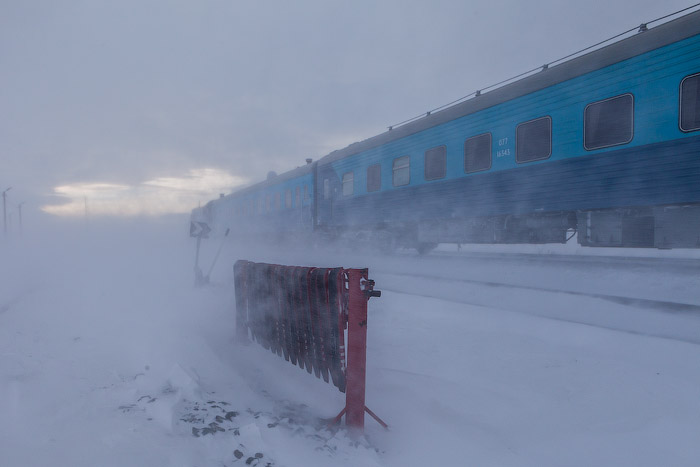
Train drivers say that certain route sections feature such queer-shaped mountains that looking at them bring about the most unexpected associations. For example, a stone pile nearby the Shchuchya River looks like a tank in the sunlight. In fact, the weather normally changes every hour on the Peninsula. We could see the Yamal clear and sunny, hazy and harsh and even got into a snowstorm during our 24-hour trip.
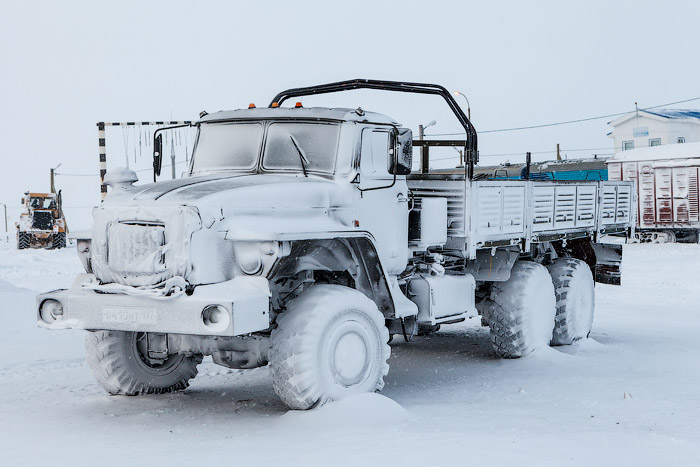
While this winter appeared to be unusually warm and snowless for Yamal, during our journey the daily temperature varied from –20 to –25 degrees Celsius and was accompanied by the wind, and the snow sometimes reached a 3-meter depth.

A heavy snowstorm left snow even in vestibules.
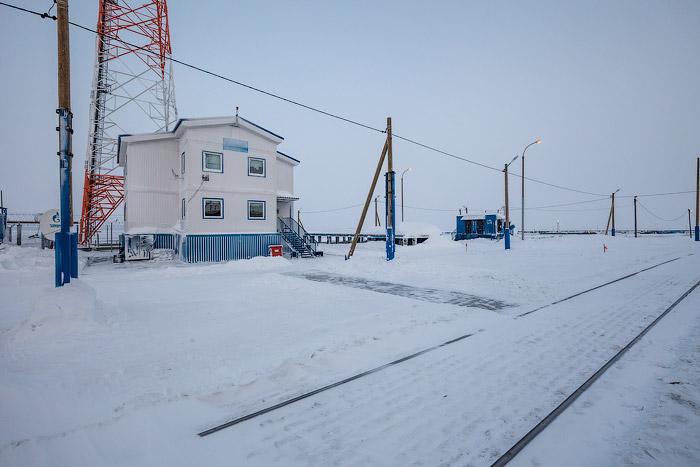
Small houses are occasionally seen in the snowy wilderness – these are living and working premises of passing track on-duty operators. Small passing tracks require two persons on duty, larger passing tracks and stations are served by dozens of ones. In total, 140 on-duty operators serve the stations and passing tracks, and over 800 persons are engaged in railroad and trains maintenance.
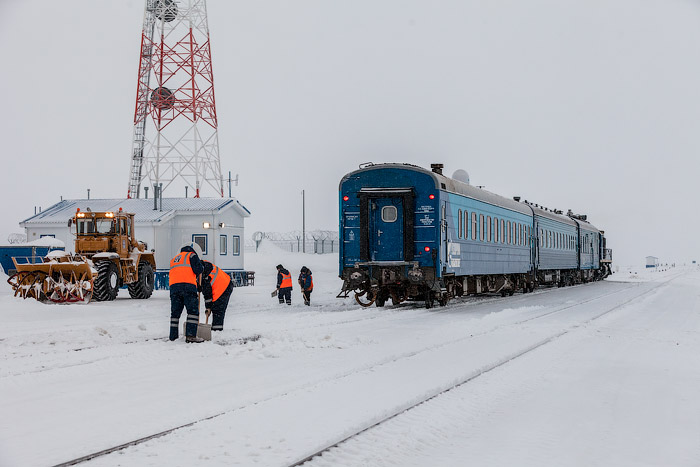
All employees of the Yamal branch of Gazprom Trans work on a shift basis, i.e. month on (with no holidays) and month off, 12-hour shift pattern. This is true for conductors, mechanics, train drivers, trouble-shooters and cleaners. The train diagram and spacing are specified by yard masters. They set the train route and the departure time.

The yard master Andrey Nyankin gets information on a train departure or arrival to a station or passing track from on-duty operators by phone and fixes all train trips in his diagram. The requirements to yard masters are quite strict. They all should be experienced as station on-duty operators and appropriately graduated.
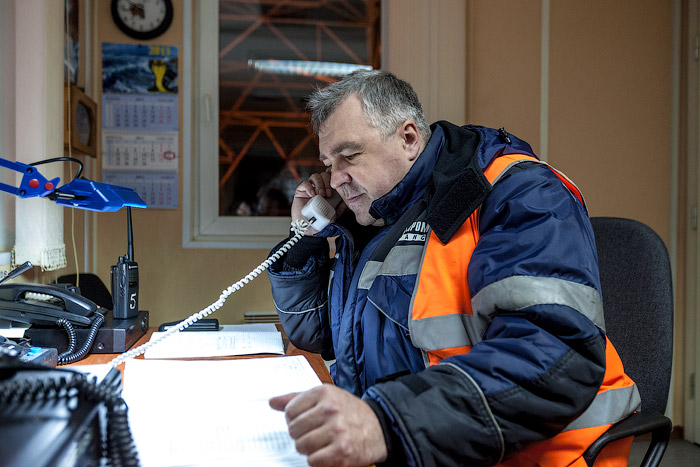
All instructions of the yard masters are followed by on-duty operators. Konstantin Olkhovka, on-duty operator at the second passing track, like all his colleagues accepts, dispatch and switches trains and provides train drivers with track permits allowing train trip till the next passing track. Yard masters are also responsible for snow removal from the passing tracks area and the railway. Track trouble-shooters are also involved in the process at large passing tracks.
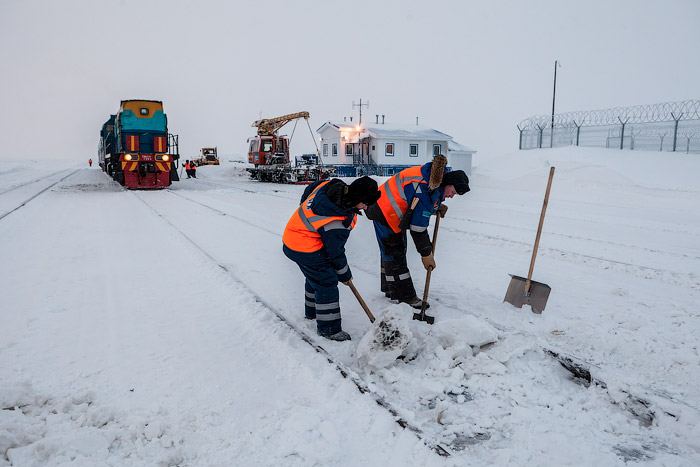
Sergey Golovanov and Anatoly Khokhrov, trouble-shooters at the Yuribey station, check rail fastenings and, if necessary, tighten the bolts as soon as snow removed. Despite the track disposition at the blowing sites, snow requires removal three times a day. The workmates acknowledge their regular dreaming of snow removal after recurrent snowstorm.
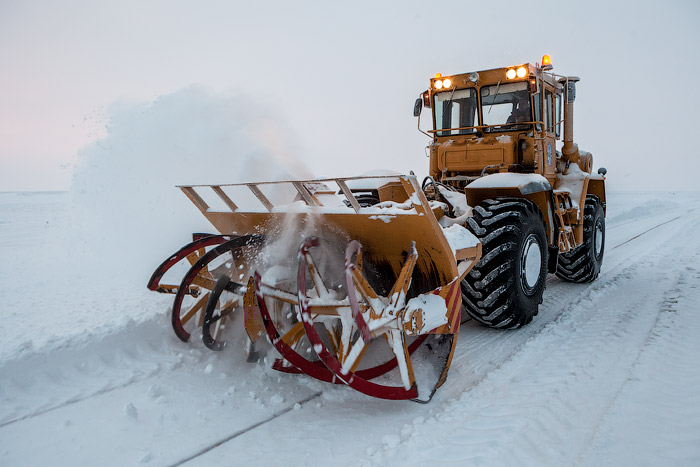
The dedicated machines are used at large passing tracks and in between to assist people. For instance, a snow-plough engine removes snow at the Obskaya 2 station and nearby. It scrapes roadside snow beneath which is then absorbed and blown out into freight cars through a special gear.
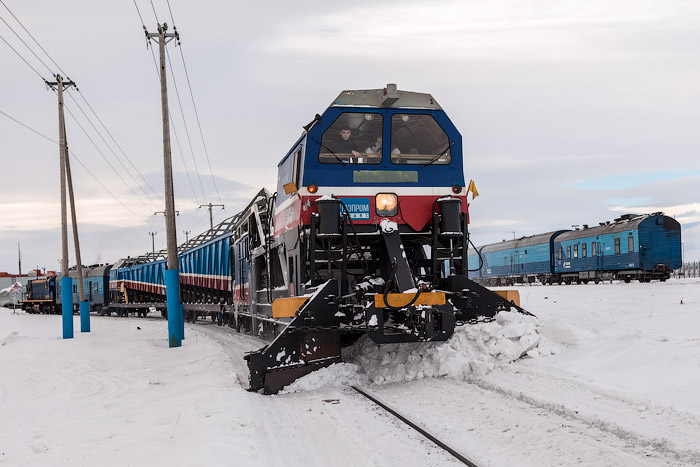
If rails are drifted up with snow, trains will cease running. A train once got stuck on the route for three days waiting for the railway to be cleared of snow.
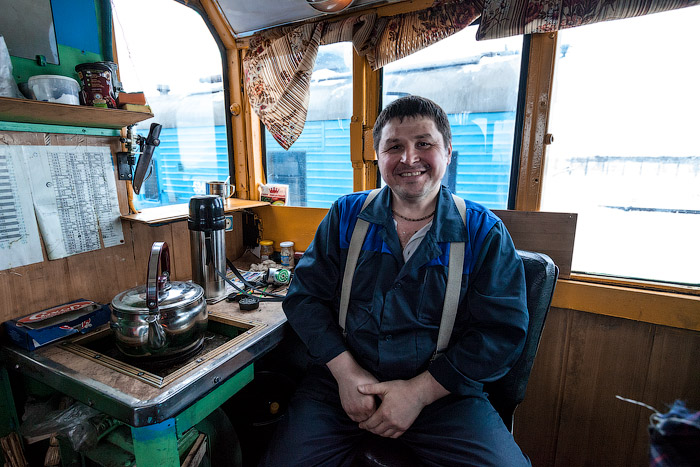
Alexey Bubnov has been working as a train driver assistant at the northern railway for as long as 3 years. “There is a transcendental craving for working in extreme environment. It’s not just driving a locomotive in here, but overcoming difficulties and overcoming yourself you understand you are really capable of something more. And you feel satisfied in the end,” Alexey said proudly.
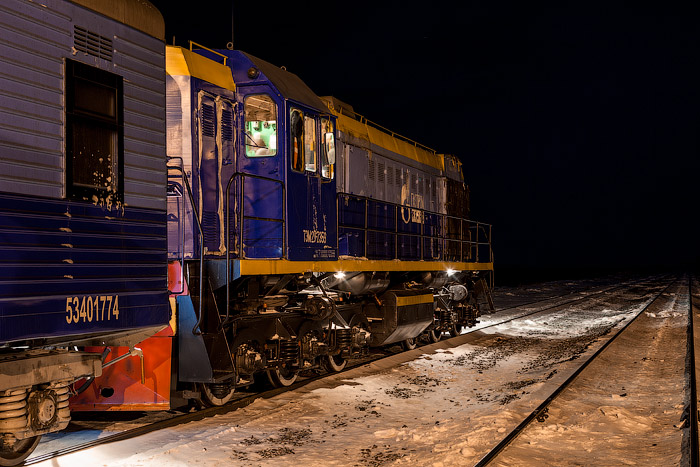
Health and Safety are the matter of critical concern for Gazprom. There has been no accident at the railway during the whole period of operation. This resulted from clear sharing of responsibilities among the Gazprom Trans employees. The same concern was shown to the employees housekeeping. After all, on-duty operators the whole month live in several dozens or even hundreds kilometers away from the mainland not leaving a passing tracks area.

A house, where a shift lives and works, is furnished with all essentials from refrigerator and washing machine to dishware and mini-bakery. Before the shift starts, the on-duty operators are brought to the food-store to buy essential food for the whole month. The working and the living areas are arranged in different premises to provide more efficient functioning.
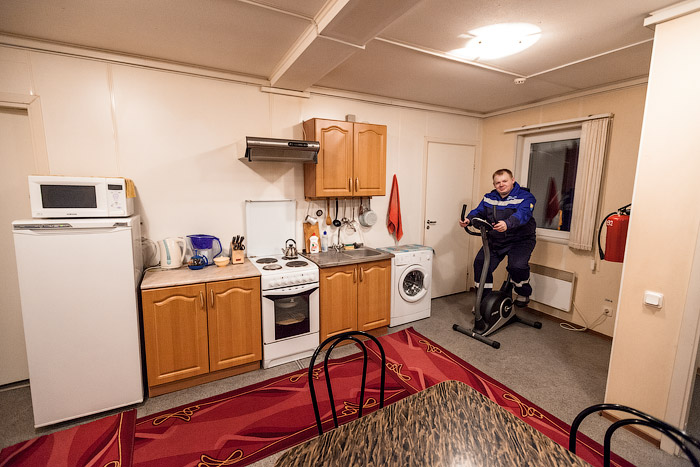
Everything is provided for adequate leisure as well. The drawing room is equipped with satellite television for a quiet rest, as well as with exercise bikes, dumbbells and barbells for an active one.
During the warm seasons the on-duty operators gather mushrooms and berries, go hunting or fishing as soon as numerous rivers and lakes of the Yamal are open.
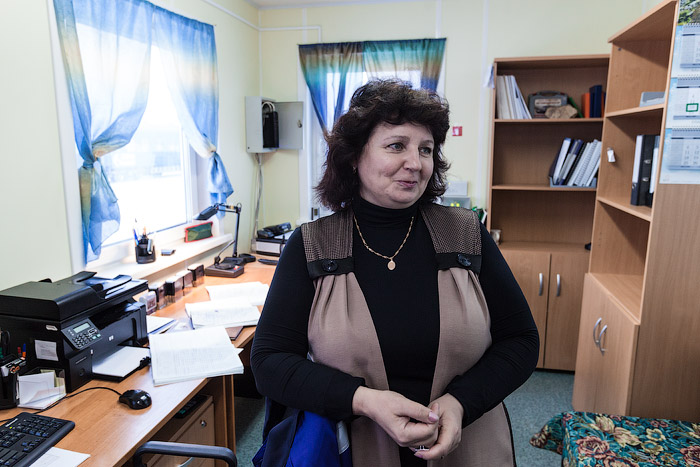
Not only is the sterner sex welcomed in severe northern surroundings. Irina Gafarova, resident of Kurgan, works as an acceptance inspector of cargos and luggage. She examines the cargo to be reliably secured and its weight not to exceed the permitted figure. All freight cars and platforms are subject to her examinations.
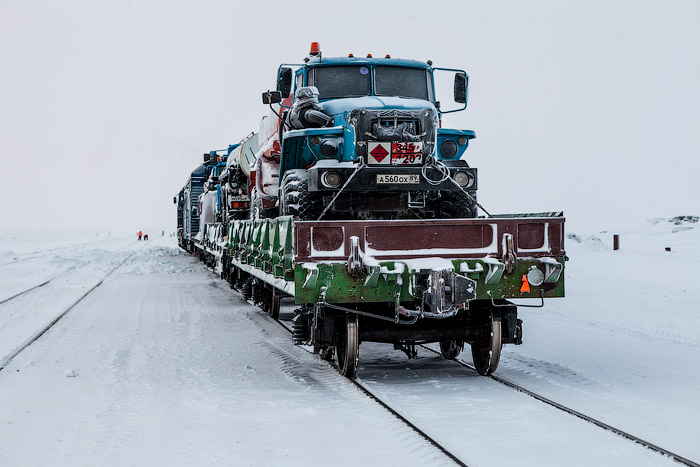
Freight cars and platforms handle equipment, construction materials and food to the residents of the shift settlement at the Bovanenkovo field and return to the mainland with gas condensate.
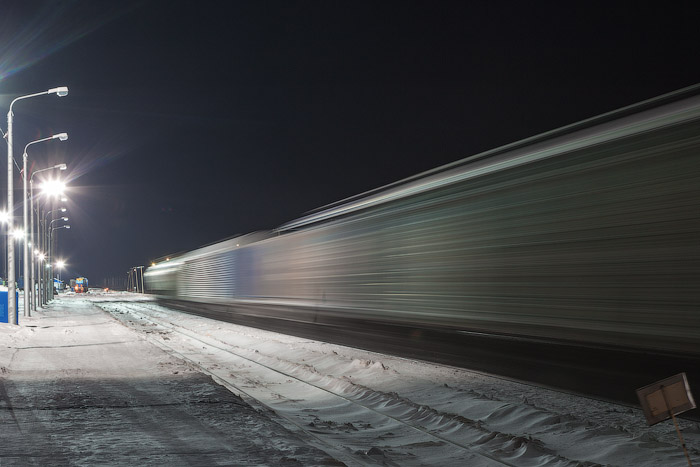
People wishing to work at the northern railway are hired all over the country. Salekhard, in spite of the relative proximity to the Peninsula, shows a lack of appropriate experts.
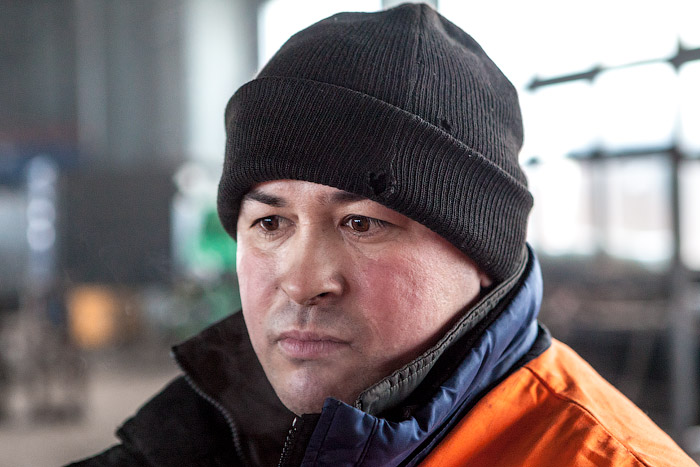
Valery Alekseev, rolling stock repairman, came from Moldavia. Being a schoolboy he was lured to the Yamal-Nenets Autonomous Area by his brother in 1986. Once obtained a profession of carpenter, Valery immedia notresizetely hired out to the railway.

Now he works in a locomotive depot. Locomotives are brought here for repair and maintenance.

The depot operates night and day and is capable of servicing up to five locomotives at once.
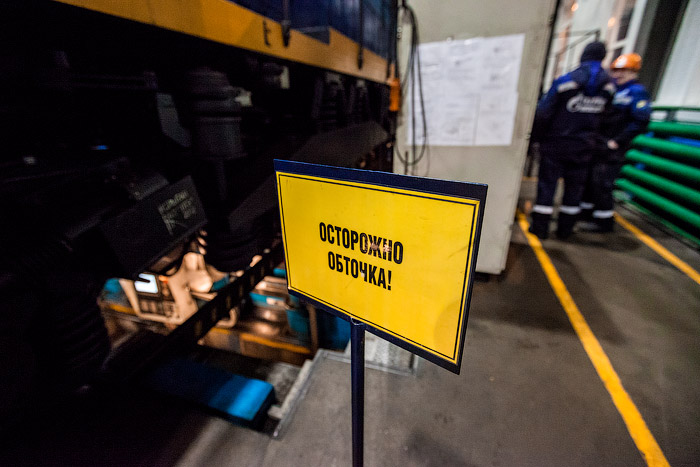
Changing or turning wheelpairs is the most routine work of the depot employees.

They are subject to fast wearing on the winding road.
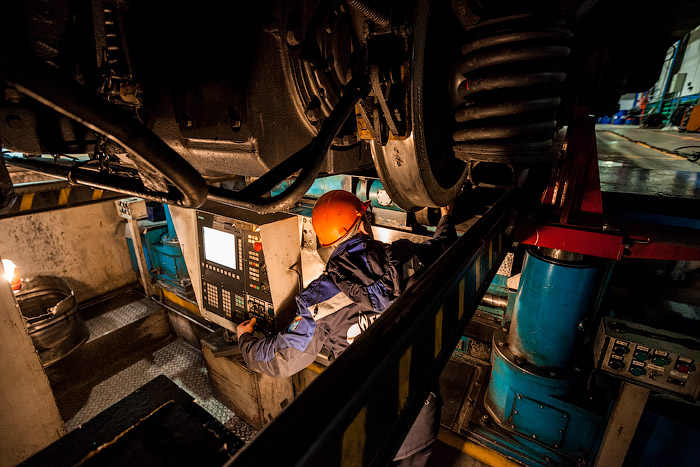
The final inspection of the train condition is carried out immedia notresizetely before its departure.

Viktor Korolyov and Sakit Suleimanov, car inspectors, walk along both sides of the train, rapping every wheelpair with a special steel bar.
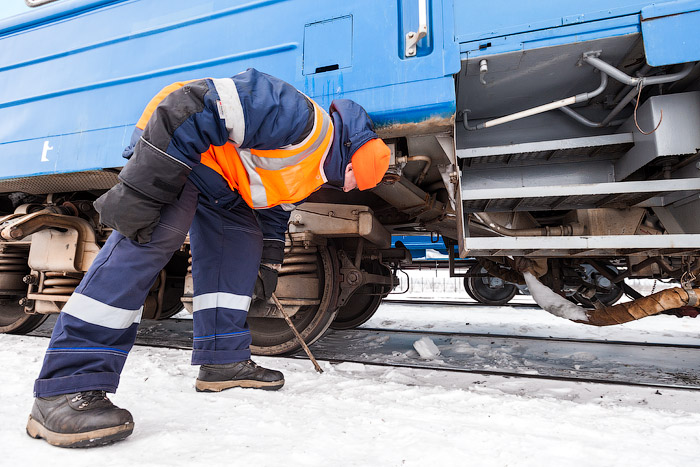
Great attention is paid to car couplings, wheels and brakes. The workmates define if the devices are in good order or failed, based on the produced sound.

The train fleet of the Yamal branch of Gazprom Trans comprises dozens of locomotives and hundreds of cars.

The brightest one is a diesel generator car of the breakdown and emergency train. This car was made for the 10th anniversary of Gazprom Trans. All employees of the Yamal branch took part in its creation.

A contest for the best picture was organized among the employees. The priority was given to the most vivid pictures of the Peninsula’s nature and traditions.
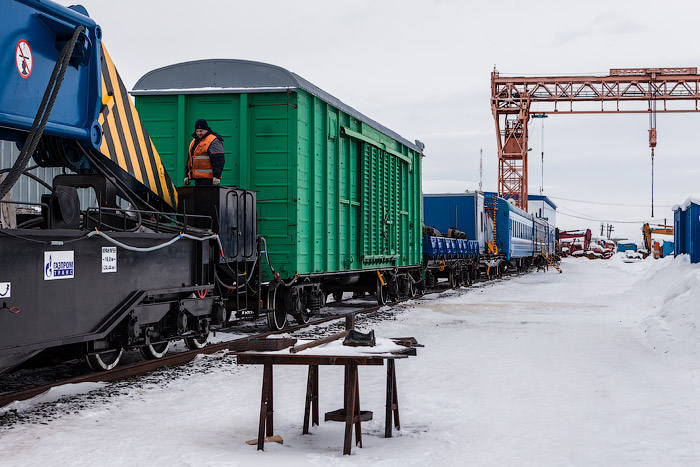
The breakdown and emergency train is an “ambulance” for troubled locomotives. It stands alert 24 hours and is designed to lift off-the-track trains. The breakdown and emergency train is equipped with two cranes of 125 and 150 tons lifting capacity, respectively, bulldozers, excavators, hydraulic equipment, bogies, auxiliary power plant and lifting gear platform.

The lifting gear car is a travelling workshop. It comprises welding station, fitting shop and joiner’s shop.
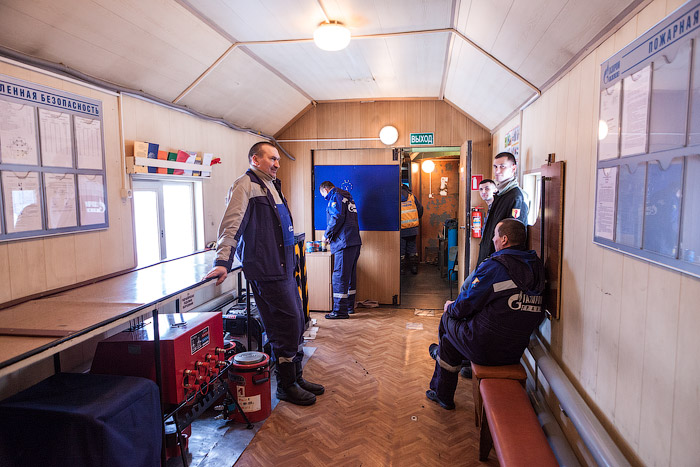
The trouble crew is comprised of 15 persons.

All the works are guided by Roman Gordeev, foreman.

The breakdown and emergency train performs its “combat missions” four times a month. But this is a regular routine. The real accident happened only once for the last three years – the train ran off the track because of the tank bogie side frame failure.
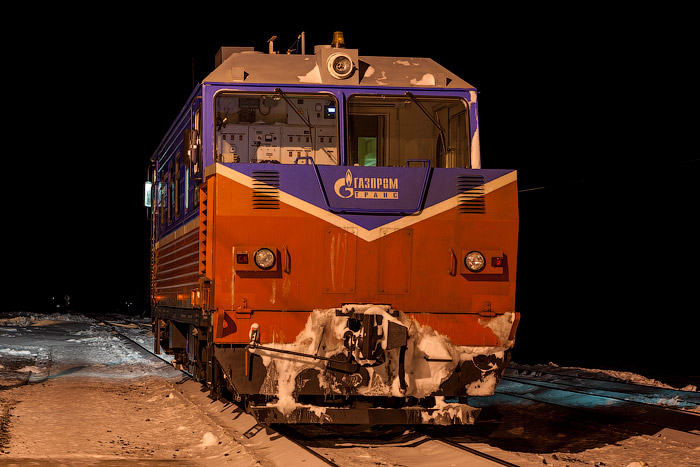
Motorailer is an indispensable assistant in preventing accidents. It comprises flaw detector and odometer. Twice a month the machine hits the road at a speed of 40 kilometers per hour to examine the railway.
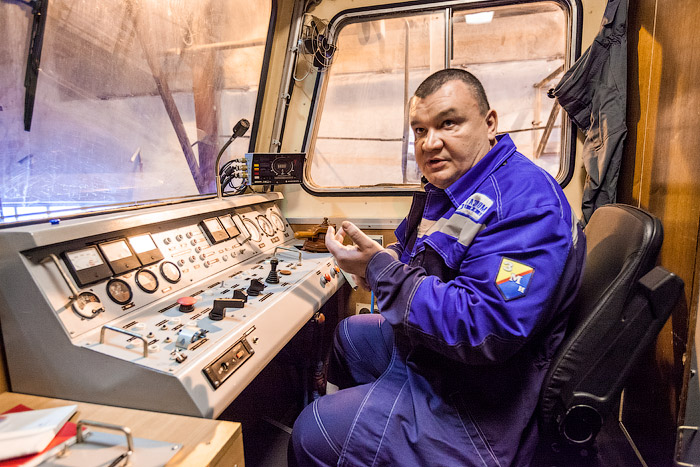
Andrey Kosyrikhin, instructor of the track machine teams, is responsible for train-driver training. He teaches newcomers to drive the locomotive, allows them to the route and constantly monitors the activity of train-drivers and their assistants. He also gives a driving examination. This examination has to be passed after every vacation. Andrey Kosyrikhin also makes irregular inspections.

The conditions of local ridership seriously differ from conventional ones. Shift workers leaving for the field arrive at the station half-day before the train departure. At the Obskaya station they are subject to health examination and personal search. The ban against alcohol is the critical stipulation for working at the railway and the field itself. Thus, those trying to bring some alcohol with them are got off the train.
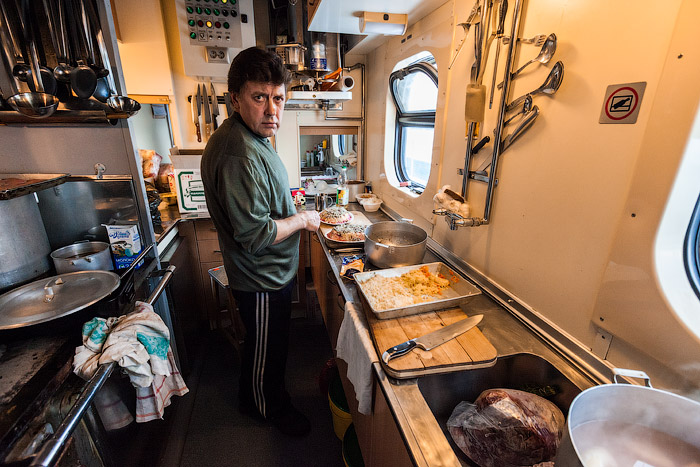
All passengers of the train are provided with bed linen and three meals daily. Oleg Bobryakov, chef, cooks for the shift workers in a buffet car.
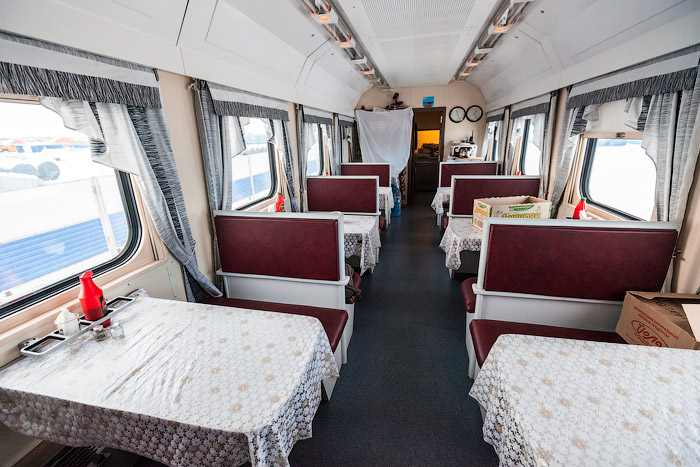
As a rule, there are two cars of that kind in the trains.

Similarly to the railway men, chefs in Gazprom Trans work on a shift basis. They live in a train all month long, even if the train doesn’t make any trip. The car is equipped with showers, kitchen and all necessary household appliances.
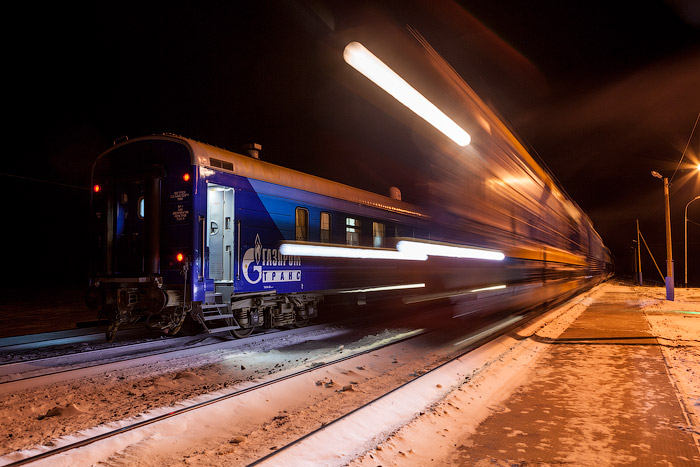
The Yamal branch of Gazprom Trans carried over 65 thousand people in 2012. Cargos are hauled from the mainland to the north and back via the railway about twice a day.
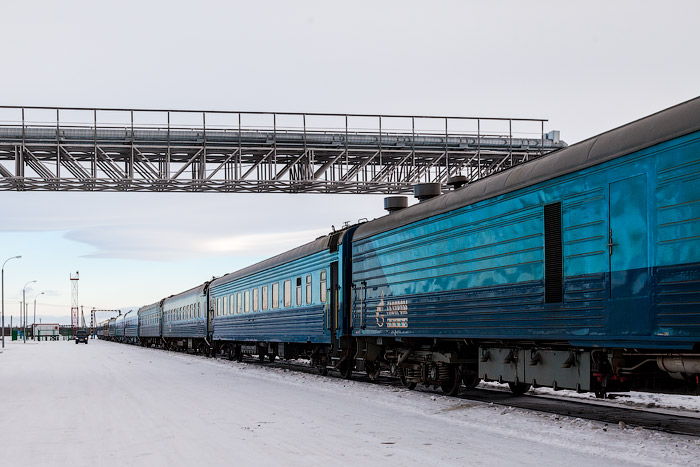
Trains carrying about 10–11 cars with shift workers to the Bovanenkovo field set off once in three days. There were maximum 16 cars with the shift workers sent to the Bovanenkovo field.
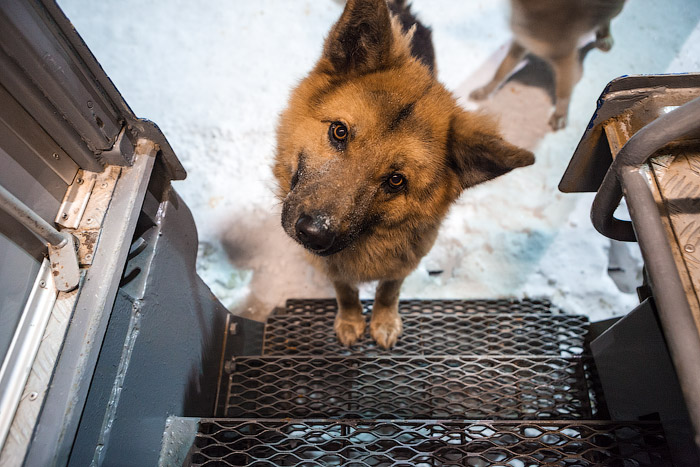
Meanwhile, the train arrived at the terminal station – the Bovanenkovo field. As we have already mentioned in the beginning, we will tell you about our staying here in the second part of the photo essay; as for now, let’s meet the local dog, Tuzik who welcomed us on the station wondering if we had anything tasty for him.

